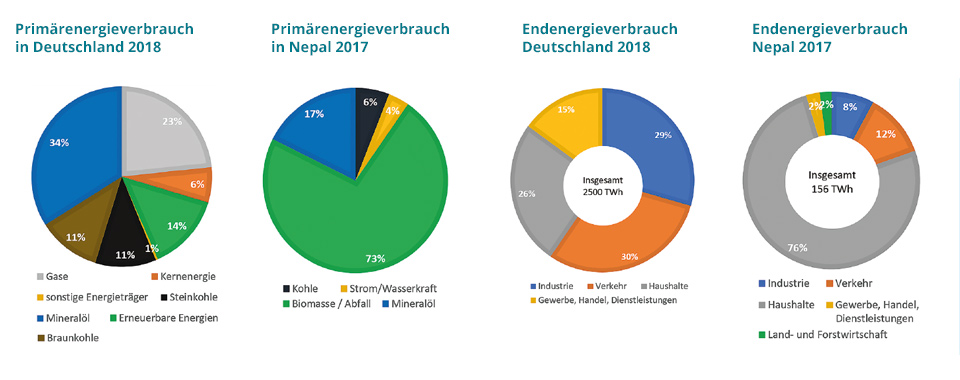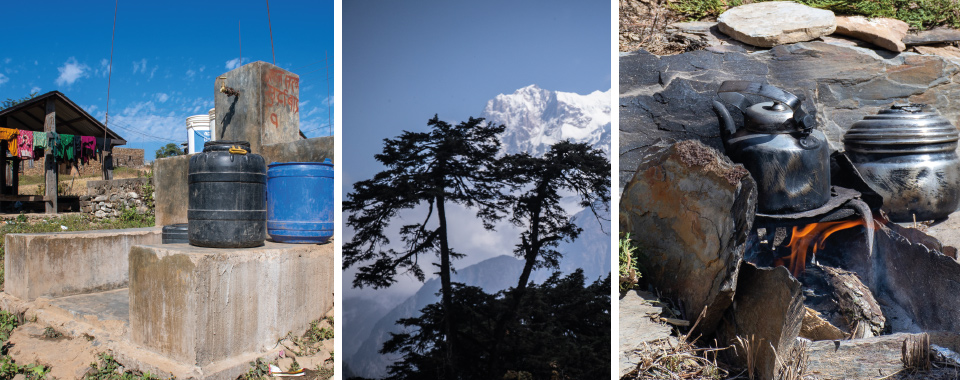The energy structure in Germany and Nepal is very different – regardless of whether it is about the energy sources, the type and amount of energy consumption or the infrastructure. In Germany, most of the energy still comes from fossil fuels. In 2018, only 13.8% of primary energy consumption came from renewable energies. Even if over 40% of the electricity sector is now generated from renewable energies, the other energy sectors are still very far from this value. In the transport and heating sectors, fossil fuels such as mineral oil and coal are still predominantly used today.
A completely different picture emerges in Nepal: The majority (72.8%) of primary energy consumption across all energy sectors comes from renewable raw materials such as wood and waste. The energy system is therefore for the most part renewable and independent of fossil resources. Nevertheless, the balance is not CO₂ neutral, because biomass such as wood or waste also generate CO₂ when burned. In contrast, in the electricity sector (only 3.7% of total energy consumption) 100% of the demand is generated from renewable energies. This is mainly due to the proximity to the Himalayan high mountain range and the great potential for hydropower that is available and used here.
Germany consumes 16 times as much energy as Nepal at 2500 terawatt hours. The high consumption shares of traffic (30.1%), industry (29.5%) and commerce, trade and services (15.0%) are due to the high degree of industrialization. Households only consume about a quarter of the final energy.
A completely different picture emerges in Nepal: More than three quarters of the final energy is consumed in households in which wood is mainly used for heating and cooking. Due to the low level of industrialization, the share of energy consumption in the transport and industrial sectors is comparatively very low.

Cycle of anthropogenic CO₂

However, the availability of renewable energies can only be controlled to a limited extent – if the wind is not blowing or the sun is not shining, no electricity can be generated from them.
That is why in the future we will have to adapt our energy consumption to the offer and combine it intelligently with storage options.[/ outerOneHalfLast]
Even if different energy systems and primary energy consumption balances exist in both countries, which could hardly be more different, the CO₂ emission values of both countries are above the permissible values that the global climate can handle.
A system change can only succeed if you are aware of the problem and the environmental impact. That is why we gave the students a feel for how technological progress, especially industrialization, had an impact on global CO₂ emissions. A study by ETH Zurich shows that global, man-made CO₂ emissions total 39.2 gigatons per year (as of 2017), and the trend is rising. Of this, nature can only cope with a certain amount (56%) of CO₂ and 44% remain in the atmosphere.
If you calculate the limit for global CO₂ emissions for the energy mix from renewable and fossil fuels on this basis, you get a value of 0.127 kgCO₂eq / kWh.
If you compare the current German energy mix (in the first figure) with this value, you can see that Germany currently emits 4.7 times the CO₂ zero-sum system with 0.569 kgCO₂eq / kWh. Nepal exceeds the value 2.8 times. This makes the Nepalese energy system significantly “greener” than the German one, but both are still a long way from a CO₂-neutral energy system.
Much still needs to be done. Climate change is a global man-made phenomenon that affects all people with ecological, economic and social consequences. The most important countermeasures include reducing greenhouse gases and establishing sustainable circulatory systems in almost all areas of life. Common and mutual learning is essential. This is the only way to better understand and shape the transformation process and to make more sustainable decisions in the future.
The focus is on learning from each other. The opportunities of the energy transition, in particular the use of water and solar energy and a systemic integration into an on-site infrastructure, seem to have been created for Nepal’s path. Conversely, Germany could learn a lot from the ease, gratitude and loving serenity of the Nepalese in order to give the energy transition and its opportunities enough space.

